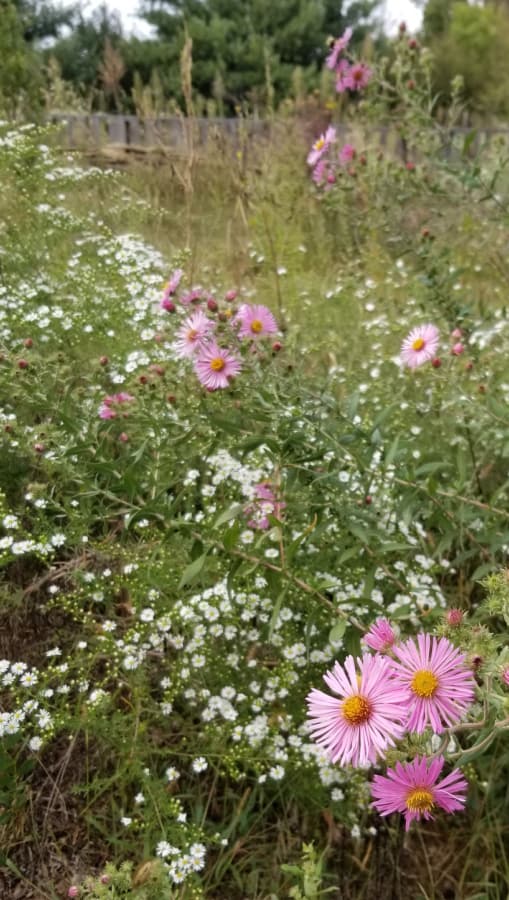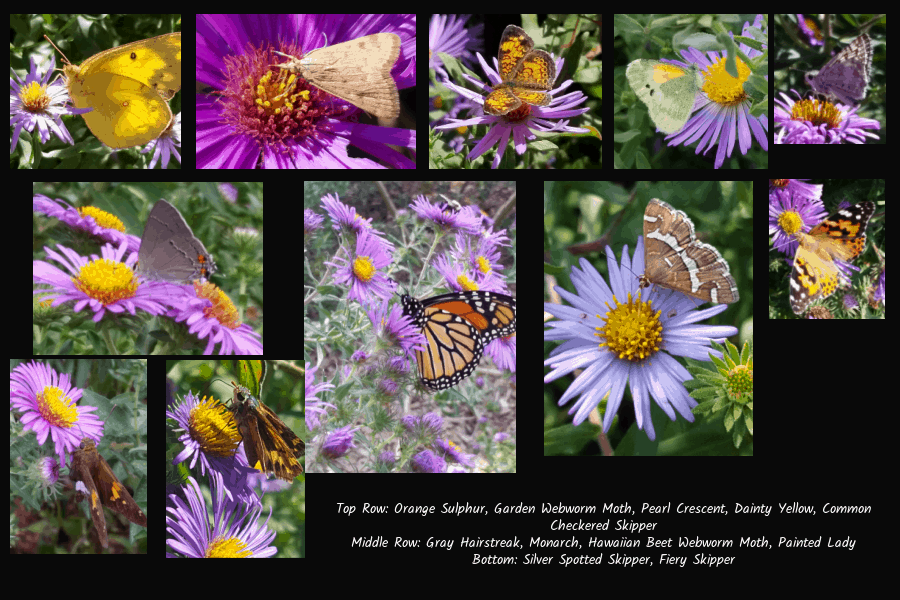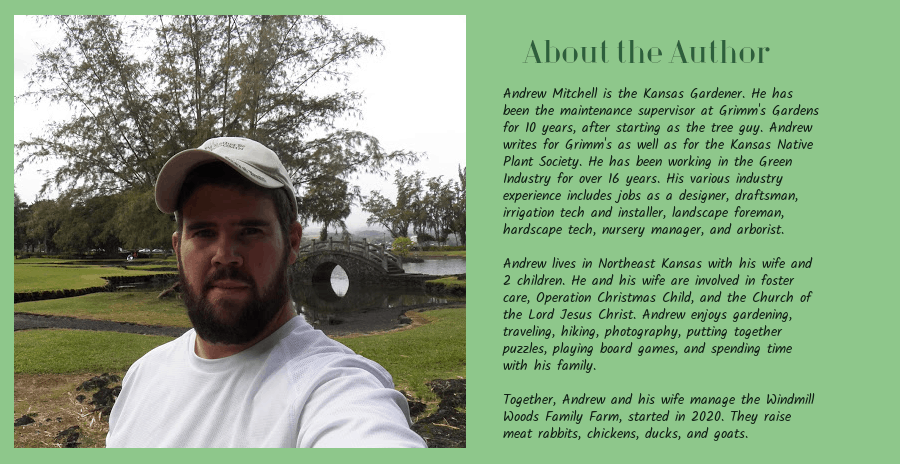Aster is our October Plant of the Month. When it comes to fall flowers, asters and goldenrods really outshine everything else. But because asters come in shades of purple, white, blue, and even pink, they are more memorable than the plain yellow goldenrods. Both are great for pollinators in late summer and into autumn, but asters steal the show in color.
There are 78 species of aster native to North America, and 23 of those can be found in the Central Great Plains and the Midwest regions. But not all of those are suited for landscape use. We have to be discerning in choosing asters to fit into our landscapes or gardens. I think there are 7 species worth diving into.
- Calico aster, Symphyotrichum laterifolium
- New England Aster, S. novae-angliae
- Heath aster, S. ericoides
- Aromatic, S. oblongifolium
- Drummond’s, S. drummondii
- Hairy, S. pilosum
- Smooth Blue, S. laeve
There are also several cultivars of aster available in the nursery whose parents are often species that do not grow native in the Plains. We will talk about them too.
Species of Aster for the Central Great Plains
Calico Aster
While I have not seen this aster growing in the wild, I thought it would be important to mention, as there is at least 1 important cultivar available of it. It is native to the Eastern U.S., from the Missouri River eastward. Therefore, it is an important species to many of the gardeners eastward.
This aster grows 2 to 3 feet tall and wide. It is native to woodland edges, so it prefers part shade or full sun with irrigation. This would be an excellent addition to the shade garden.
‘Lady in Black’ is the noteworthy cultivar. It has dark purple leaves throughout the growing season, which may fade to dark green in extremely hot weather. The white flowers are set nicely in autumn against the dark foliage. Grows 3 feet tall and wide.
New England Aster

This is one of my favorite species of aster. It is native to the upper Midwest, central Great Plains, and New England states. For asters, it is very tall, often growing to 6 or 7 feet. It forms a wide clump, about 3 to 4 feet, spreading by rhizomes and seed. I have found it in ditches, woodland edges, and open meadows in Northeast Kansas.
In the ditch by my house, I found it growing with a variety of color mutations. Normally rich purple, there were light pinks, dark pinks, and mauve. I was able to get a start of the light pink one for my garden. The flowers are 1.25 inches across and very attractive to bumblebees.
There are several cultivars of New England aster, because people like the color variation so often found in the wild.
- ‘Andenken an Alma Potschke’ – a more compact plant at 4 feet tall by 3 feet wide with magenta flowers.
- ‘Harrington’s Pink’ – taller at 6 feet by 2 feet wide, probably would need staking, but has large 2.5 inch flowers in light pink.
- ‘Purple Dome’ – this is a new one in the Green Industry. It is very compact at 2 feet tall and wide, with rich purple flowers.
- ‘September Ruby’ – another compact variety at 4 feet tall by 3 feet wide, with ruby-rose flowers.
- ‘Wedding Lace’ – this was the only white flowering cultivar I saw, growing 5 feet tall and wide.
Heath Aster
The heath aster is named after the European heath, for it looks very similar when not blooming. However, once autumn arrives, this aster erupts in a blizzard of snow-white flowers. It grows by rhizomes and spread by seeds, so it can fill a space quickly. It prefers well-drained to dry, sandy soils, making it an excellent plant for drier areas.
Heath aster grows 2 feet tall and the flowers are 1/2 inch across. The reason I included this in the list is because I think it has a possible place in the landscape, being very drought tolerant, and having a unique texture. Mixed into a perennial border, I think it would be wonderful with butterfly milkweed, catmint, and ornamental onion.
There are actually a few cultivars of this plant, but they may be difficult to find.
- ‘Snow Flurry’ – is only 8 inches tall, making it a great full sun groundcover.

Aromatic Aster
This may be the best aster for landscapes and gardens. It is bushy, and rounded, and spreads mostly by rhizomes, though it does seed out as well. One of the best traits is that it is the last thing to bloom in my garden in fall.
I have seen it start blooming as early as September, but usually it does not start until early October. It will keep blooming through the first frost and even several hard freezes. I have seen it still in bloom as late as December 9th in Northeast Kansas.
Aromatic aster grows 2 to 4 feet tall and can spread as wide as 6 feet. It is very drought tolerant. The blooms are lavender purple to almost blue. There are 2 easy to find cultivars.
- ‘Raydon’s Favorite’ – lavender blue flowers on a 3 foot tall by 5 foot wide plant.
- ‘October Skies’ – purple-blue flowers on a 3 foot tall by 5 foot wide plant.


Drummond’s Aster
There are several species of asters found growing in woodlands or woodland edges, but the Drummond’s aster is my favorite. A reliable bloomer in the shade, it grows 3 to 5 feet tall (flower spike) and 1 to 2 feet wide. It spreads by seed and grows in a clump form, with a rosette of heart-shaped leaves.
The flowers are powder blue to white with a center that starts yellow then turns red. There are no cultivars, but it crosses readily with other woodland asters.
Hairy Aster
Another under-utilized aster, this plant has a long bloom time in autumn. It starts blooming in August (sometimes July) and goes steadily into October, up the the first frost. Small white flowers cover a 4 to 5 foot tall plant, that grows in a thicket of stems. It spreads by rhizomes and seed, and can be difficult to control in a garden, but is excellent in a prairie or meadow garden.
There are no cultivars of this densely hairy aster, but it mixes well with goldenrods and liatris.

Smooth Blue Aster
The last aster on my list is smooth blue. This one is great, for it does not form large colonies of plants like many others, and the leaves and stems are completely smooth, without any hairs or roughness. Growing slowly by rhizomes, it looks great in the meadow. It grows 1 to 4 feet tall and 4 feet wide. The flowers bright, sky blue in color.
A noteworthy cultivar is ‘Bluebird’ which grows 4 feet tall by 3 feet wide.
Cultivars of Asters for the Garden
One of the East Coast asters, S. novi-belgii, has been used much in the breeding of aster cultivars for the garden, since it is shorter than many other asters. The following list includes some of the better aster cultivars in production.
- ‘Wood’s Blue’ – deep blue flowers atop a 1 foot tall by 2 foot wide plant.
- ‘Wood’s Purple’ – royal purple flowers on a 9 inch tall by 30 inch wide plant.
- ‘Eventide’ – has purple flowers on a 3 foot tall and wide plant.
- ‘Crimson Brocade’ – semi-double red flowers atop a 3 foot tall and wide plant.
- ‘Bonny Blue’ – a unique blue flowered cultivar with white centers (disc flowers) on a 1.5 foot tall by 1.5 foot wide plant.
Problems of Asters
While most of the asters growing wild seem to have little or now issues, once we introduce them into the garden setting, things pop up. Because our gardens are usually not designed to mimic nature, we have less ecological benefits of the native spaces.
Insect Pests
- Spider Mites – these are not usually a huge problem on asters, but during a dry season, they can attack and suck the life right out of the plant. In the landscape, I recommend using Fertilome’s Rose and Flower Food plus Systemic to treat all plant-sucking insects.
- Lacebugs – another plant-sucking insect, these attack asters in mid-summer. Characterized by pale, spotted leaves and black specking on the undersides of the leaves, if left untreated, the plant with lose all the lower leaves and flowering will be reduced.
Diseases
- Powdery mildew – is the biggest disease problem with asters, though most of the cultivars listed in this post are resistant to it. Powdery mildew is most common when plants do not get enough air movement around them, and water or moisture builds up on the leaves. Most garden settings have this problem, so planting resistant varieties is the best remedy.
Pollinators of Asters
I did not mention caterpillars that feed on asters as a pest, because I think that they are a part of the ecosystem and should be encouraged, not removed. NOTE: Using Fertilome’s Rose and Flower Food plus Systemic will not harm caterpillars, only plant sucking insects such as lacebugs, spider mites, whiteflies, and aphids.
The following is a list of moths and butterflies that us various aster species as a host plant for their caterpillars.
- Silvery checkerspot butterfly
- Pearl crescent butterfly
- Saddleback caterpillar moth
- Asteroid Moth
- Confused Euscara moth
- Common pug moth
- Common tan wave moth
- Isabella tiger moth
- Arcigera flower moth
- Goldenrod flower moth
- Wavy-lined emerald moth
Photos of pollinators at work
Many different species of insects use asters as food and provide pollination services in return. All many of pollinators, such as bees, beetles, flies, moths, butterflies, and wasps all use these late season flowers.


Companion Plants for Aster
Because asters are mostly late summer to late fall blooming plants, it is best to put them into a flower bed with plants that can fill the flowering gaps before. Or use them in a meadow garden with other natives and grasses, so they shine when they need to.
Perennials to pair with asters in a flower garden/landscape
- Baptisia ‘Cherries Jubilee’, ‘Sparkling Sapphires’, ‘Lemon Meringue’
- Showy Penstemon
- Culver’s Root
- Prairie Blazingstar
- Greyhead Coneflower
- Purple Coneflower
- Butterfly Milkweed
- Goldenrod ‘Fireworks’
- Tall Garden Phlox
- Sedum ‘Autumn Fire’
- Rudbeckia ‘American Gold Rush’, ‘Glitters Like Gold’, ‘Little Henry’
Annuals to pair with asters in a flower garden/landscape
- Mexican sunflower (Tithonia)
- Zinnias
- Brazilian Verbena
- Globe Flower ‘Truffala Pink’
- Salvias
- Pineapple Sage
- Clasping Coneflower (Rudbeckia amplexicaulis)
Conclusion
Looking forward to autumn and the end of the growing season does not have to be hard when you start adding more asters into your landscape. I especially look forward to all the bees and butterflies that flock to my aromatic asters in the garden. I hope you find an aster that works well for you.
Happy planting!




